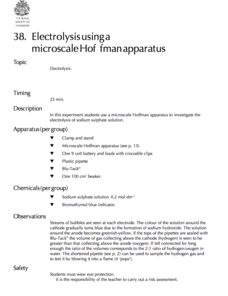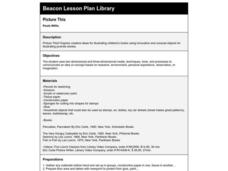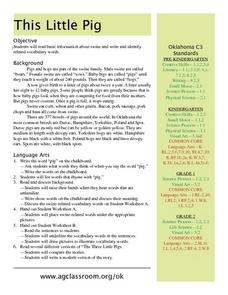Novelinks
The Little Prince: Blooms’ Taxonomy Questions
Question what you read with a lesson based on Bloom's Taxonomy. As kids read The Little Prince by Antoine de Saint-Exupéry, they formulate questions with cues from a graphic organizer, and answer them to work on critical thinking skills.
Curated OER
The Old Man and the Sea: Questioning Strategies
Readers learn to ask questions about text with an activity based on Ernest Hemingway's The Old Man and the Sea. As they read, class members craft questions based on Bloom's Taxonomy and then find the answers themselves.
Novelinks
Wildwood Dancing: Guided Imagery
Reader's of Wildwood Dancing engage in a guided imagery exercise designed to encourage them to visualize the setting of Juliet Marillier's young adult fantasy novel.
Virginia Department of Education
Chemical Bonds
How are chemical bonds similar and how are they different? Provide your young chemists with the resources to more thoroughly understand the concepts of ionic and covalent bonds. Pupils research these topics, diagram examples of each...
National External Diploma Program Council
Capitalization Review
Using correct grammar is a capital idea! Elementary readers review the rules of capitalization, including proper nouns, abbreviations of organizations, and holidays, before correcting the errors in two sets of sentences.
BBC
The Role of a Monarch (key stage 2 and 3)
What makes a good monarch? Elementary and middle schoolers examine popular symbols of the British monarchy before designing a television advertisement about the qualities needed in a monarch. Next, they write poems using metaphors and...
Royal Society of Chemistry
Electrolysis Using a Microscale Hoffman Apparatus—Microscale Chemistry
Get big results out of a small-scale lab! Young chemists observe the electrolysis of sodium sulfate using a microscale experiment. A colorful indicator solution combined with the production of gas bubbles yields a variety of observations...
Houghton Mifflin Harcourt
Person to Person: English Language Development Lessons (Theme 4)
Help language learners understand words and cultural concepts. The second installment in a series of three language development lessons designed to accompany Theme 4: Person to Person helps bridge the gap for language learners by...
Curated OER
Where's My Dot?
Students explore the five basic elements of Monart, dot, curved line, straightline, and angle line to create a book about their home address. The concept of "big" is explored in this lesson.
Curated OER
Picture This
Fourth graders use two-dimensional and three-dimensional media, techniques, tools, and processes to communicate an idea or concept based on research, environment, personal experience, observation, or imagination.
Curated OER
Time For A Change: Illustrated Plates
Students create illustrated plastic plate designs depicting a physical, chemical, or biological change of some kind after investigating the artwork of porcelain artist Kataro Shirayamadani.
Curated OER
Researching and Writing Travel Brochures
Students design a travel brochure. In this travel brochure lesson, students review travel brochures and discuss a travel adventure they would like to go on. Students prepare an outline of their own brochure with itinerary.
Curated OER
Author, Author!
Third graders, in groups, select and research a favorite studenT author or illustrator. They answer questions about the author, conduct research and prepare a PowerPoint presentation with their findings.
Curated OER
Classroom Unity Representing a Nation of Immigrants
Investigate national unity in a month-long lesson. After creating "I am from" poems, 5th graders will construct accordion flip books, listing and illustrating reasons for settlement. Choosing illustrations, essays, or Powerpoint...
Curated OER
Multiple Intelligences and Holistic Models
Tenth graders identify different genres of literature and the characteristics which identify each genre. They identify which genres best suit their interests, read a novel and perform a skit from the novel or present original artwork...
Curated OER
Seeing is Understanding
Third graders practice visualizing elements from a story. They discuss the transition from picture books to chapter books. While reading a passage aloud, the instructor models what they see as they read the passage. Students draw a...
Curated OER
Planets in a Row
Learners use Internet to research and take notes about each planet for a fact book. They then illustrate each page in the fact book and check their facts with a solar system key. When finished, they display their work and share new facts...
Curated OER
The Tropical Rain Forest
Young scholars use various web sites to access information about the rain forest. They use the Tropical Rainforest Interactive CD to make their own rain forest pictures and stories and learn facts about the rain forest. They use various...
Curated OER
Star 5 W's
In this 5 W's worksheet, students identify key elements from a book they have read: who, what, where, why, when. Students write details in the five points of a star and illustrate the book in the center.
Curated OER
Snap a Picture
Students practice using visualization to aid in their reading comprehension. While completing a read aloud of a selected poem, the instructor models visualizing images from the poem. Independently, students read a chapter from a...
Curated OER
This Little Pig
First graders study basic information about swine. They write and identify vocabulary words relating to the subject. They write a recipe for "Pigs in a Blanket," using canned crescent rolls and small sausages. They trade recipes and...
Curated OER
Bill of Rights Day
Fifth graders examine and identify the values and purposes of the Bill of Rights. They complete a class KWL chart, participate in a class jigsaw activity, write and illustrate a book about the first ten amendments, participate in a mock...
Curated OER
At the Farm
In this sight words worksheet, students read a short book about people and animals on a farm. Students may also color in the illustrations.
Curated OER
What Hatches?
In this sight words worksheet, students read a short book about animals catching from eggs. Students may also color in the illustrations.

























